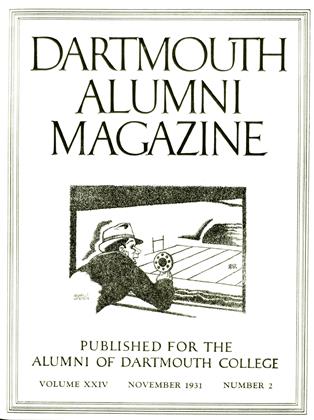1362. By Eric P. Kelly, The Macmillan Company, New York, 1931. pp. 215.
In this charming story of medieval Poland, Mr. Kelly continues to interpret for the young people of America the spirit and history of the people he knows and loves so well. It is a stirring story too, full of the adventure and mystery and glamour that every redblooded boy and girl enjoys.
The scene of the story lies in and about the ancient ruined city of Halich on the southeastern marches of Poland the red land. The period is the middle of the fourteenth century, just as Poland under King Kazimir was beginning to recover from the terrible ravages of the Tartars but with its borderland still a waste, subject to the frequent raids of hostile neighbors. The story begins with the visit of King Kazimir to his city of Lvov where an attempt is made to assassinate him. The attempt fails, thanks to the quick wit of young Michael Korzets whose father is a Polish noble in the service of the King. As a reward, King Kazimir permits Michael to join his father in an expedition to Halich from whence have come disquieting rumors of the gathering of many peoples, led there, they say, by the Golden Star. The purpose of the expedition is to discover what the Golden Star might be, and what its menace to Poland.
Upon approaching Halich the expedition is surprised by the Tartars and Michael becomes the prisoner of Duke Lev of Halich. While a prisoner in Halich Michael not only discovers what the Golden Star is, but also the nature of the mysterious conspiracy coming to a head under the symbol of the Golden Star. This, he learns, is nothing less than an attempt to replace the former emperor, John Kantakuzene on the throne of the Eastern Roman Empire, and through a system of intricate and daring alliances to restore the prestige of the Empire, drive back the Turks and bring peace to eastern Europe. Michael then witnesses the gathering of the leaders with their armies, the coming of the Emperor and the coronation of the Golden Star. Then comes the disastrous collapse of the conspiracy followed by the attack of the treacherous Tartars upon Krylos, the citadel of Halich. Fortunately, Michael has succeeded, through his gypsy friend Stasko, in warning his father of events in Halich, and just as the Tartars seem about to overwhelm the defenders they are driven from the field by the Polish knights from Lvov, and Michael and his friends are saved.
This sketchy outline of the story, of course, does scant justice to the thrilling adventures of Michael in Halich. It says nothing of his quarrel with the astrologer Phokas or of his hairbreadth escape from death at the hands of the dwarf, Krok. Nor does it tell of the gypsy, Stasko, the contest between the wandering minstrels, or of his charming little companion Katerina whom he finally discovers to be the Golden Star of Halich, the symbol under which the peoples of eastern Europe believed a third Rome would arise. It conveys too, little of the dramatic character of the story, or of the picture of medieval Poland that the reader receives.
To the reviewer whose interest is primarily in history one of the most striking features of Mr. Kelly's story is the very substantial amount of historical research upon which it is based. Indeed, there are probably very few scholars in the United States today who have a more thorough knowledge of Polish history than Mr. Kelly. Equally impressive is his knowledge, from personal observation and study, of the topographical background of his story. It is this careful attention to historical and topographical detail that has enabled Mr. Kelly to make this tale of fourteenth century Poland seem so real to the reader.
All in all, the Golden Star of Halich is a rattling good historical story, and one that young America should thoroughly enioy.
 View Full Issue
View Full Issue
More From This Issue
-
 Article
ArticleThe Class of Nineteen Thirty-five
November 1931 By E. Gordon Bill -
 Sports
SportsFootball at Dartmouth in the Year 1931
November 1931 By Sidney C. Hayward -
 Class Notes
Class NotesCLASS of 1910
November 1931 By "Hap' Hinman -
 Class Notes
Class NotesCLASS of 1930
November 1931 By Albert I. Dickerson -
 Class Notes
Class NotesCLASS of 1926
November 1931 By J. Branton Wallace -
 Class Notes
Class NotesCLASS of 1929
November 1931 By Frederick William Andres
W. R. Waterman
-
 Books
BooksTHE PAGEANT OF AMERICA
AUGUST, 1928 By W. R. Waterman -
 Books
BooksTHE MISSISQUOI LOYALISTS
October 1938 By W. R. Waterman -
 Books
BooksA HISTORY OF AMERICAN ECONOMIC LIFE
October 1951 By W. R. Waterman -
 Books
BooksA SHORT HISTORY OF AMERICAN LIFE.
October 1952 By W. R. Waterman -
 Books
BooksEASTWARD THE SEA.
JULY 1959 By W. R. WATERMAN -
 Books
BooksTHE ROAD TO RENO.
June 1962 By W. R. WATERMAN
Books
-
 Books
BooksTHE RETURN OF ADAM SMITH
April 1950 By Bruce W. Knight -
 Books
BooksTHE MOST AMAZING BUT TRUE.
JUNE 1966 By JOHN HURD '21 -
 Books
BooksDeath of the Visual
MAY 1983 By Jon H. Appleton -
 Books
BooksTHE AMERICAN WOMAN
June 1944 By Ralph P. Holben -
 Books
BooksViewpoints
JAN./FEB. 1979 By RALPH STEINER '21 -
 Books
BooksTHE NEGRO IN THE ELECTRICAL MANUFACTURING INDUSTRY.
MAY 1972 By ROBERT M. MACDONALD


